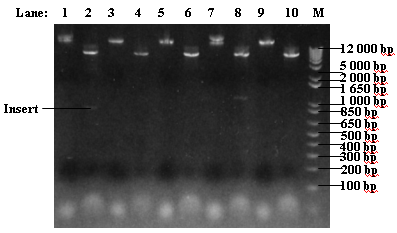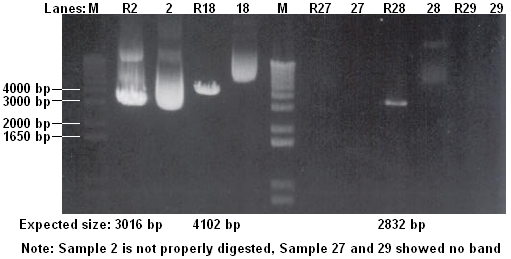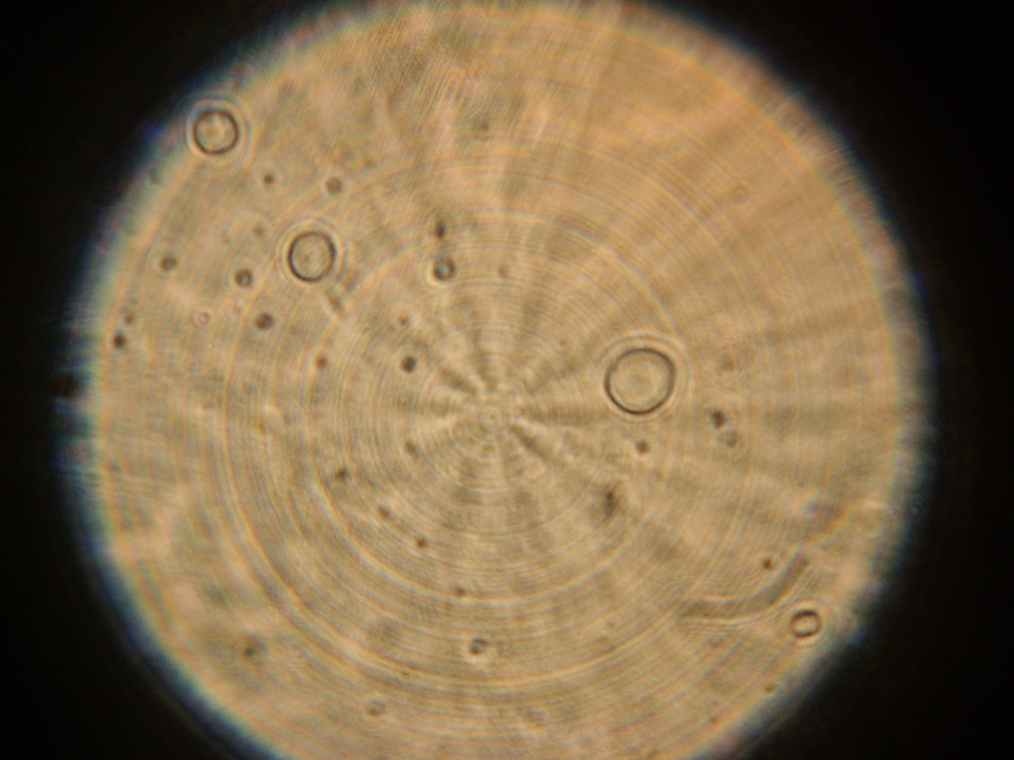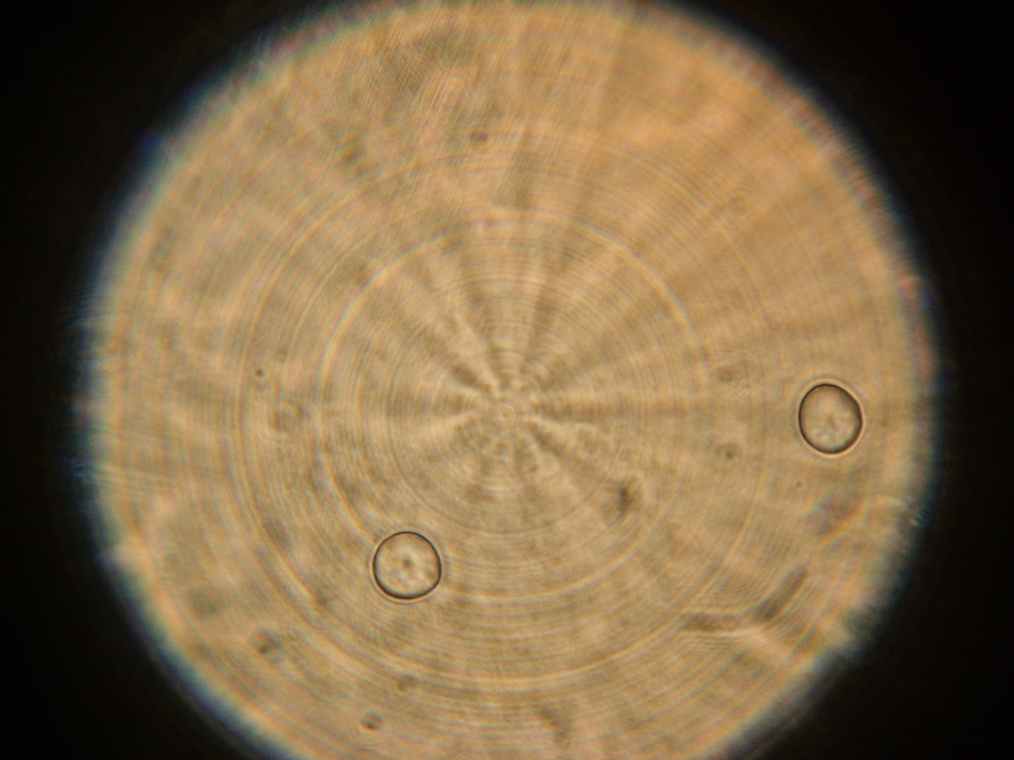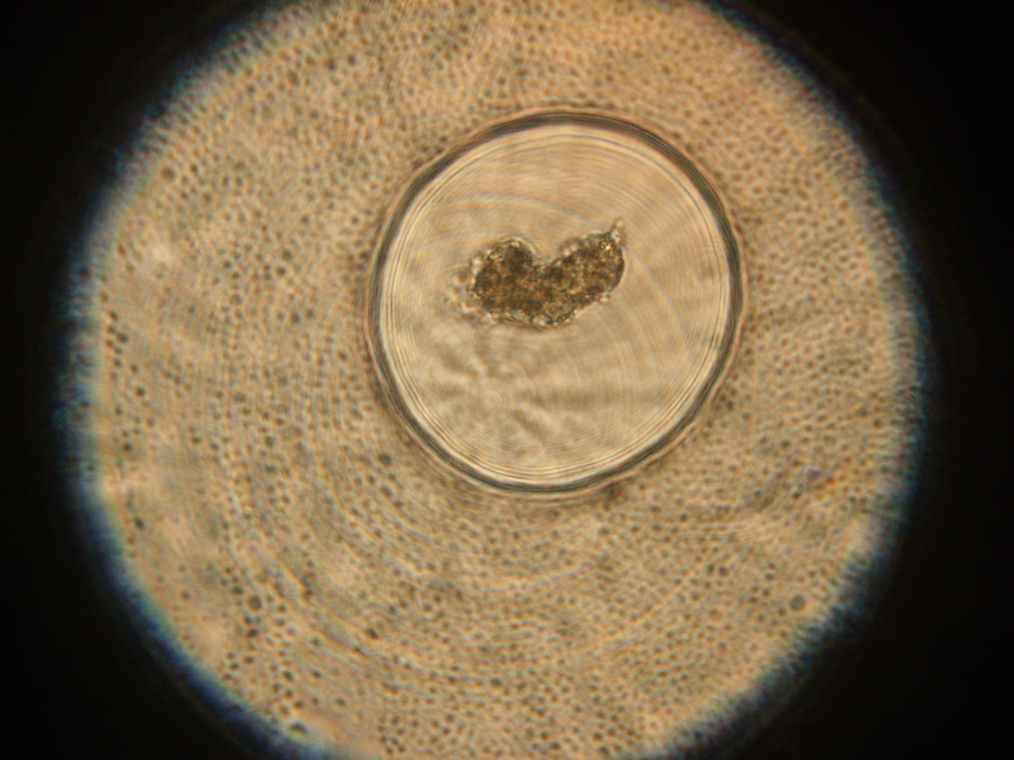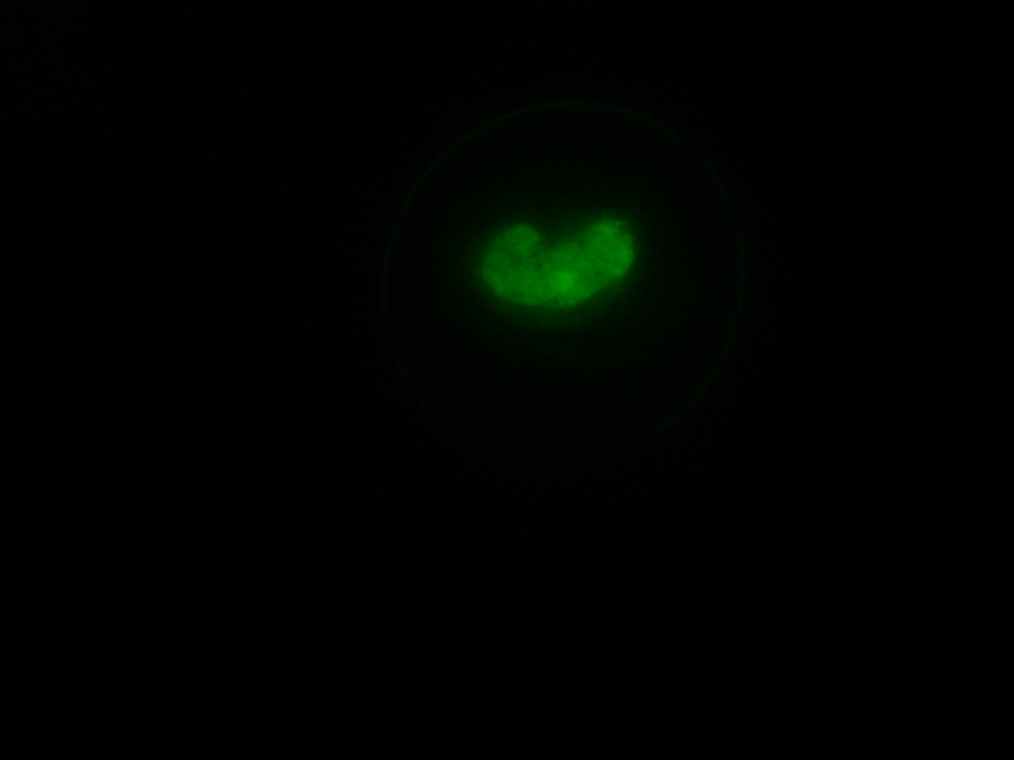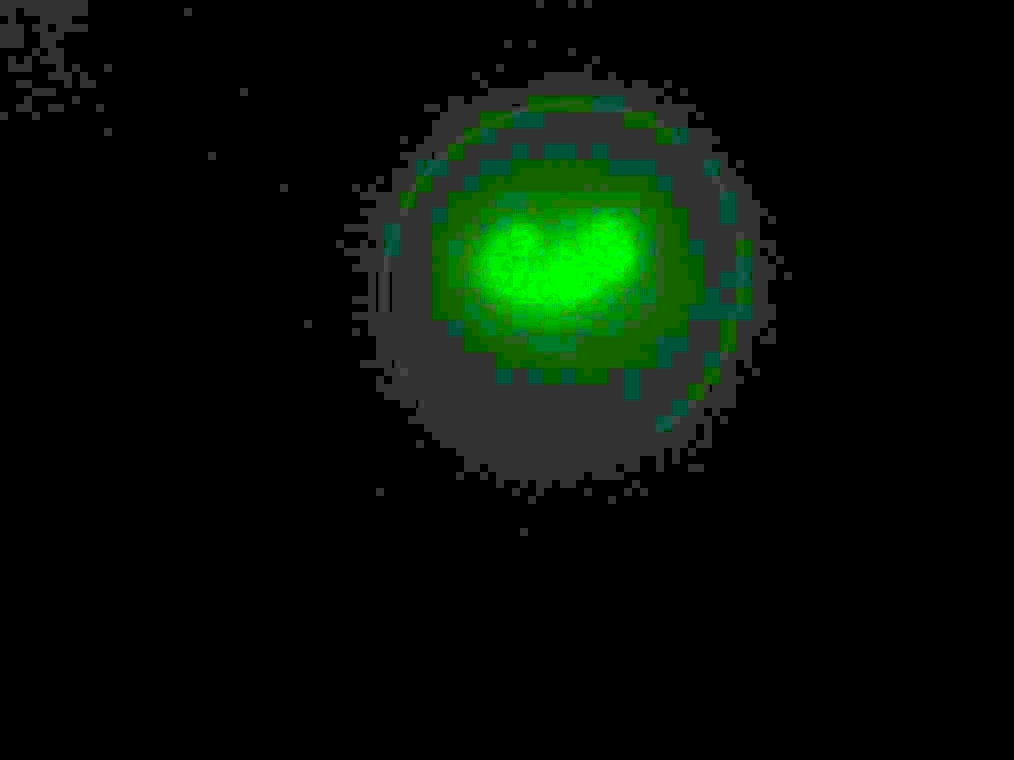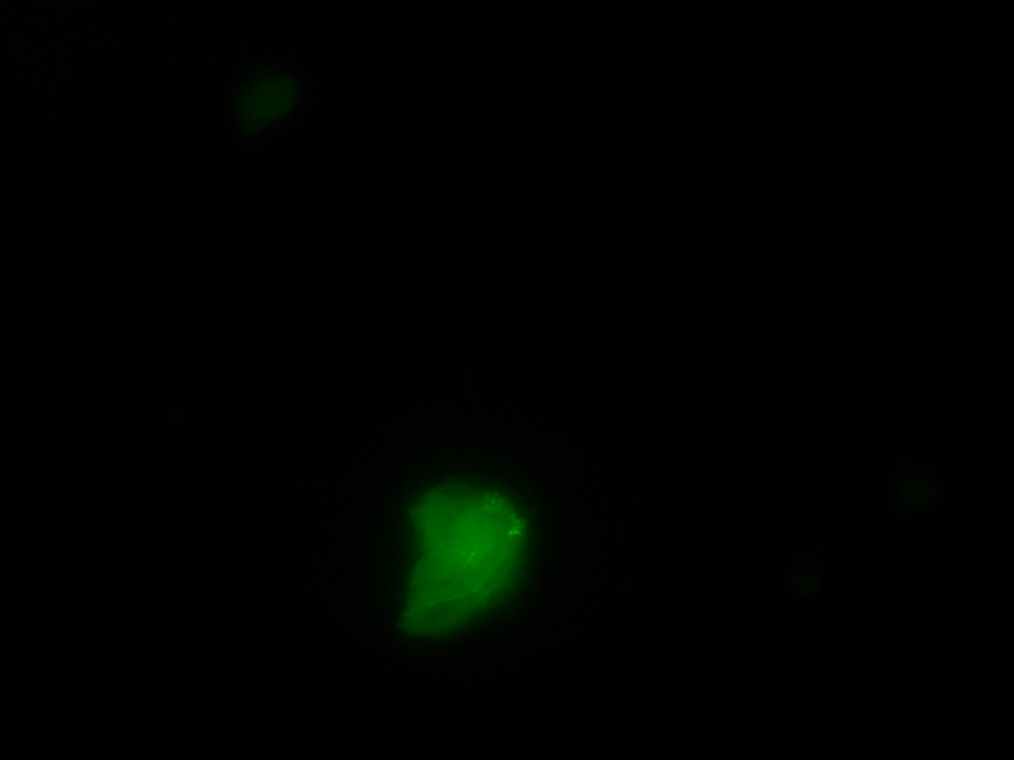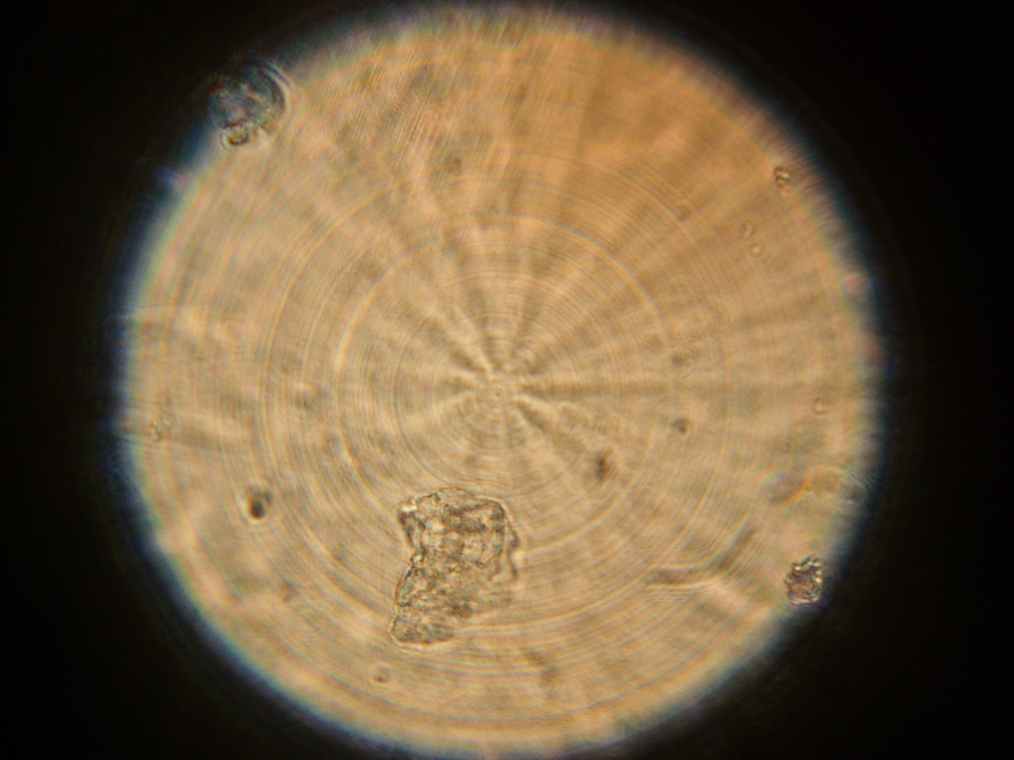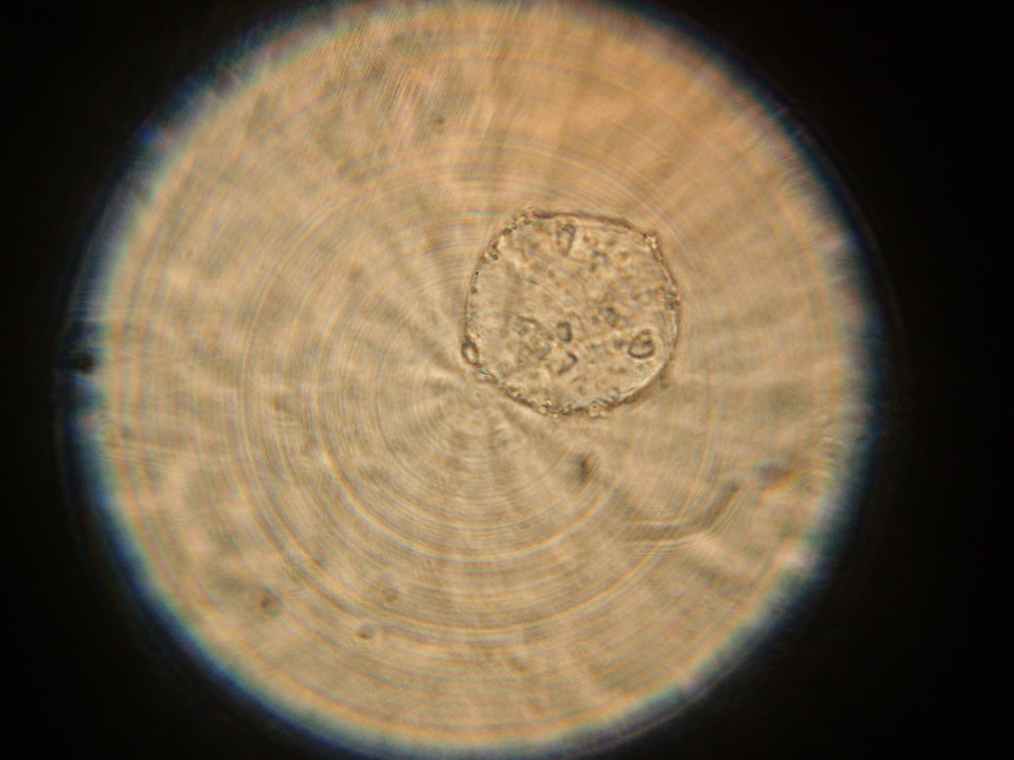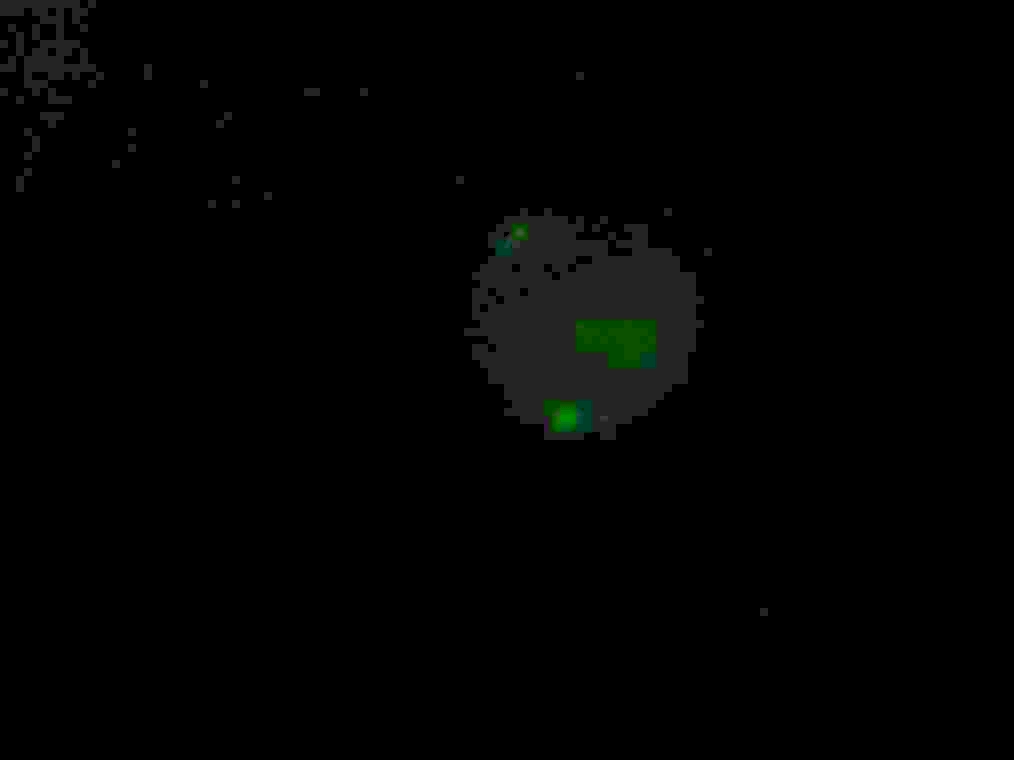Imperial/Wet Lab/Lab Notebook/2007-09-03
From 2007.igem.org
m (→Construction of pT7-GFP) |
|||
| (4 intermediate revisions not shown) | |||
| Line 1: | Line 1: | ||
{{Template:IC07navmenu}} | {{Template:IC07navmenu}} | ||
<html><div id="maincol"></html> | <html><div id="maincol"></html> | ||
| - | + | __NOTOC__ | |
= 3 September 2007 = | = 3 September 2007 = | ||
| + | ==Construction of pT7-GFP== | ||
| + | #Minipreped the 5 overnight cultures | ||
| + | |||
| + | Protocols can be found at [http://www.openwetware.org/wiki/IGEM:IMPERIAL/2007/Notebook/General_Protocols#S30.2FS12_Cell_Extract#Miniprep| Miniprep] in the general protocols page | ||
| + | |||
| + | #Digested 5μl of DNA with Nde1 and BamH1 | ||
| + | #Checked the digestion on 1% agarose gel | ||
| + | #*1. Colony 1 | ||
| + | #*2. Colony 1 digested | ||
| + | #*3. Colony 2 | ||
| + | #*4. Colony 2 digested | ||
| + | #*5. Colony 3 | ||
| + | #*6. Colony 3 digested | ||
| + | #*7. Colony 4 | ||
| + | #*8. Colony 4 digested | ||
| + | #*9. Colony 5 | ||
| + | #*10. Colony 5 digested | ||
| + | #Colonies 1 and 4 show the correct-size insert upon digestion | ||
| + | |||
| + | [[Image:ICGEMS T7GEL4.PNG|350px]] | ||
| + | |||
| + | Protocols can be found at [http://www.openwetware.org/wiki/IGEM:IMPERIAL/2007/Notebook/General_Protocols#Electroporation| Electroporation] in the general protocols page | ||
| + | |||
| + | #Transformed recombinant plasmid DNA into BL21 | ||
| + | #Plated transformed cells onto LB + Kan plates | ||
| + | #Left plates at 37°C overnight | ||
| + | |||
| + | Protocols can be found at [http://www.openwetware.org/wiki/IGEM:IMPERIAL/2007/Notebook/General_Protocols#S30.2FS12_Cell_Extract#Transformation| Transformation] in the general protocols page | ||
| + | |||
| + | ==Maxiprep of Biobricks== | ||
| + | #Maxipreped 2 Biobricks | ||
| + | |||
| + | <font size=-2> | ||
| + | *2. BBa_I13422 [ptet-GFP] | ||
| + | *18. BBa_T9002 [plux-GFP] | ||
| + | </font> | ||
| + | |||
| + | Protocols can be found at [http://www.openwetware.org/wiki/IGEM:IMPERIAL/2007/Notebook/General_Protocols#S30.2FS12_Cell_Extract#Maxiprep| Maxiprep] in the general protocols page | ||
| + | |||
| + | [[Image:ICGEMS Gel 3 9.png]] | ||
| + | |||
| + | Conclusions: | ||
| + | *Part 2 is very concentrated! | ||
| + | *Part 27 and 29 are not cloned properly | ||
| + | |||
| + | == Vesicles == | ||
| + | '''Formation of Vesicles''' | ||
| + | |||
| + | For both the POPC/dodecane 10ml and DOPC/dodecane 10ml suspensions prepared today - without overnight incubation - the following steps were taken: | ||
| + | * 2ml of suspension was taken to prepare an interface according to protocol. | ||
| + | * 25μl of 100x diluted GFP solution was used to prepare the emulsion; stirred gently with magnetic stirrer. | ||
| + | |||
| + | '''NOTE: There was a mistake in labelling the containers for the two suspensions - both were mistakenly labelled as DOPC. When the mistake was spotted, it was impossible to distinguish between the POPC and DOPC containers. The labels used then were a best guess, and have been carried through the remainder of these results. So, please bear in mind that the results given could either be POPC or DOPC.''' | ||
| + | |||
| + | 4 samples prepared: | ||
| + | * Sample 1: 1ml of POPC/dodecane/GFP emulsion added over interface prepared with 2ml of POPC/dodecane suspension. | ||
| + | * Sample 2: 1ml of DOPC/dodecane/GFP emulsion added over interface prepared with 2ml of DOPC/dodecane suspension. | ||
| + | * Sample 3: 2ml of POPC/dodecane/GFP emulsion, with no previously prepared interface. | ||
| + | * Sample 4: 2ml of DOPC/dodecane/GFP emulsion, with no previously prepared interface. | ||
| + | |||
| + | Samples 1 and 2 were centrifuged at 120x g. | ||
| + | Samples 3 and 4 have been left overnight for sedimentation to occur. | ||
| + | |||
| + | |||
| + | '''Results''' | ||
| + | Samples 1 and 2 were collected for observation under the microscope. The following results were obtained: | ||
| + | * Sample 1: Vesicles observed, but not photographed. | ||
| + | * Sample 2: Vesicles observed. | ||
| + | |||
| + | {|align="left" border="1" | ||
| + | | width="200px"| [[image:IC07_image137.jpg|200px]] | ||
| + | | width="200px"| [[image:IC07_image136.jpg|200px]] | ||
| + | |- | ||
| + | |colspan="2" width="400px"|Vesicles found in Sample 2. Above left: Several vesicles under white light. Above right: The same objects (not visible), under fluorescence. The fluorescence was present and visible, but VERY faint. The camera was unable to register the fluorescence - even with 4 seconds of exposure. Gamma and saturation corrections did not reveal any colour. Below left: Another pair of vesicles. Below right: Again, the fluorescence inside these vesicles was too faint to be captured by the camera, but it was visible. | ||
| + | |- | ||
| + | | width="200px"| [[image:IC07_image139.jpg|200px]] | ||
| + | | width="200px"| [[image:IC07_image138.jpg|200px]] | ||
| + | |}<br clear="all"> | ||
| + | |||
| + | {|align="left" border="1" | ||
| + | | width="200px"| [[image:IC07_image141.jpg|200px]] | ||
| + | | width="200px"| [[image:IC07_image140.jpg|200px]] | ||
| + | | width="200px"| [[image:IC07_image140b.jpg|200px]] | ||
| + | |- | ||
| + | |colspan="3" width="600px"|A strange object seen in Sample 1. Left: A very large object, containing a membrane and a large GFP aggregate. The texture outside the object is rough, while smooth inside. The circular boundary is actually in aqueous solution, but it is not clear if the inside is GFP in water, air, or oil. Centre: The same object, under fluorescence. Right: The picture in the centre, but with gamma correction and full saturation. Note the grey circular object enclosing the bright GFP clump. The grey area is actually an effect from the gamma correction, enhancing a very faint fluorescence. In fact, when looked at in the microscope, the whole circular object emitted a very faint green fluorescence (besides the GFP aggregates), with a very clear boundary along the circular border seen under white light. This indicates that there was some GFP dissolved inside the object, suggesting that it may have been aqueous GFP solution. | ||
| + | |}<br clear="all"> | ||
| + | |||
| + | {|align="left" border="1" | ||
| + | | width="200px"| [[image:IC07_image132.jpg|200px]] | ||
| + | | width="200px"| [[image:IC07_image133.jpg|200px]] | ||
| + | |- | ||
| + | |colspan="2" width="400px"|Typical GFP aggregates, this time found in Sample 2. Aggregates like these have been, so far, the most abundant source of fluorescence in our samples. They range from tiny sub-1μm specs (all over the place) to gigantic blobs more than 1mm across (rare). Left: The aggregate under white light. Right: The same aggregate, with fluorescence. | ||
| + | |}<br clear="all"> | ||
| + | |||
| + | {|align="left" border="1" | ||
| + | | width="200px"| [[image:IC07_image135.jpg|200px]] | ||
| + | | width="200px"| [[image:IC07_image134.jpg|200px]] | ||
| + | | width="200px"| [[image:IC07_image134b.jpg|200px]] | ||
| + | |- | ||
| + | |colspan="3" width="600px"|Another strange object, this time seen in Sample 2. Left: The object under white light. Centre: The same object, with fluorescence. Right: The picture in the centre, but with gamma correction and full saturation. Note the grey circular object in the enhanced image. As with the strange object seen in Sample 1, the grey pixels actually correspond to very faint fluorescence, enhanced by gamma correction. This shows how the rough circular object was in fact enclosing a few GFP aggregates as well as a diluted GFP solution. Could this be a very large vesicle? It is about 30μm across. Why would it have such a rough surface? | ||
| + | |}<br clear="all"> | ||
| + | |||
| + | |||
| + | '''Preparations''' | ||
| + | |||
| + | Three experiments were set up for tomorrow: | ||
| + | |||
| + | # One 100ml beaker with 250μl of POPC and 50ml of dodecane | ||
| + | # One 50mm by 25mm cylinder with 50μl of POPC and 10ml of dodecane | ||
| + | # One 50mm by 25mm cylinder with 50μl of DOPC and 10ml of dodecane | ||
| + | |||
| + | All desiccated and sonicated, and left on the bench overnight (not the incubator). | ||
<html></div></html> | <html></div></html> | ||
{{Template:IC07labnotebook}} | {{Template:IC07labnotebook}} | ||
Latest revision as of 14:45, 26 October 2007

3 September 2007
Construction of pT7-GFP
- Minipreped the 5 overnight cultures
Protocols can be found at [http://www.openwetware.org/wiki/IGEM:IMPERIAL/2007/Notebook/General_Protocols#S30.2FS12_Cell_Extract#Miniprep| Miniprep] in the general protocols page
- Digested 5μl of DNA with Nde1 and BamH1
- Checked the digestion on 1% agarose gel
- 1. Colony 1
- 2. Colony 1 digested
- 3. Colony 2
- 4. Colony 2 digested
- 5. Colony 3
- 6. Colony 3 digested
- 7. Colony 4
- 8. Colony 4 digested
- 9. Colony 5
- 10. Colony 5 digested
- Colonies 1 and 4 show the correct-size insert upon digestion
Protocols can be found at [http://www.openwetware.org/wiki/IGEM:IMPERIAL/2007/Notebook/General_Protocols#Electroporation| Electroporation] in the general protocols page
- Transformed recombinant plasmid DNA into BL21
- Plated transformed cells onto LB + Kan plates
- Left plates at 37°C overnight
Protocols can be found at [http://www.openwetware.org/wiki/IGEM:IMPERIAL/2007/Notebook/General_Protocols#S30.2FS12_Cell_Extract#Transformation| Transformation] in the general protocols page
Maxiprep of Biobricks
- Maxipreped 2 Biobricks
- 2. BBa_I13422 [ptet-GFP]
- 18. BBa_T9002 [plux-GFP]
Protocols can be found at [http://www.openwetware.org/wiki/IGEM:IMPERIAL/2007/Notebook/General_Protocols#S30.2FS12_Cell_Extract#Maxiprep| Maxiprep] in the general protocols page
Conclusions:
- Part 2 is very concentrated!
- Part 27 and 29 are not cloned properly
Vesicles
Formation of Vesicles
For both the POPC/dodecane 10ml and DOPC/dodecane 10ml suspensions prepared today - without overnight incubation - the following steps were taken:
- 2ml of suspension was taken to prepare an interface according to protocol.
- 25μl of 100x diluted GFP solution was used to prepare the emulsion; stirred gently with magnetic stirrer.
NOTE: There was a mistake in labelling the containers for the two suspensions - both were mistakenly labelled as DOPC. When the mistake was spotted, it was impossible to distinguish between the POPC and DOPC containers. The labels used then were a best guess, and have been carried through the remainder of these results. So, please bear in mind that the results given could either be POPC or DOPC.
4 samples prepared:
- Sample 1: 1ml of POPC/dodecane/GFP emulsion added over interface prepared with 2ml of POPC/dodecane suspension.
- Sample 2: 1ml of DOPC/dodecane/GFP emulsion added over interface prepared with 2ml of DOPC/dodecane suspension.
- Sample 3: 2ml of POPC/dodecane/GFP emulsion, with no previously prepared interface.
- Sample 4: 2ml of DOPC/dodecane/GFP emulsion, with no previously prepared interface.
Samples 1 and 2 were centrifuged at 120x g. Samples 3 and 4 have been left overnight for sedimentation to occur.
Results
Samples 1 and 2 were collected for observation under the microscope. The following results were obtained:
- Sample 1: Vesicles observed, but not photographed.
- Sample 2: Vesicles observed.
Preparations
Three experiments were set up for tomorrow:
- One 100ml beaker with 250μl of POPC and 50ml of dodecane
- One 50mm by 25mm cylinder with 50μl of POPC and 10ml of dodecane
- One 50mm by 25mm cylinder with 50μl of DOPC and 10ml of dodecane
All desiccated and sonicated, and left on the bench overnight (not the incubator).
